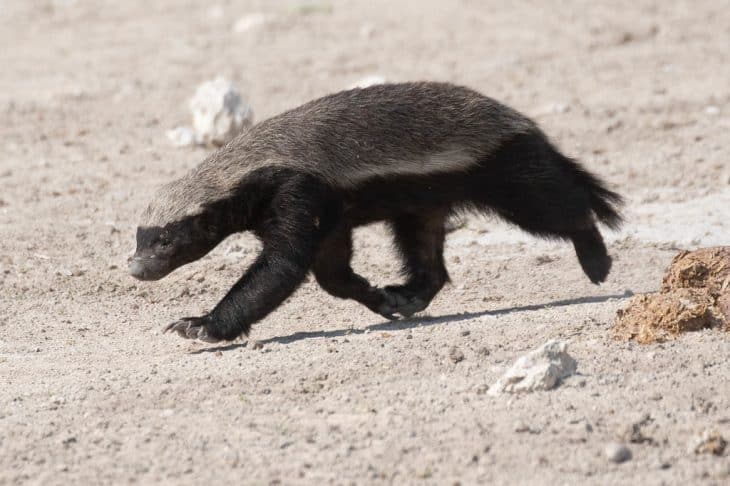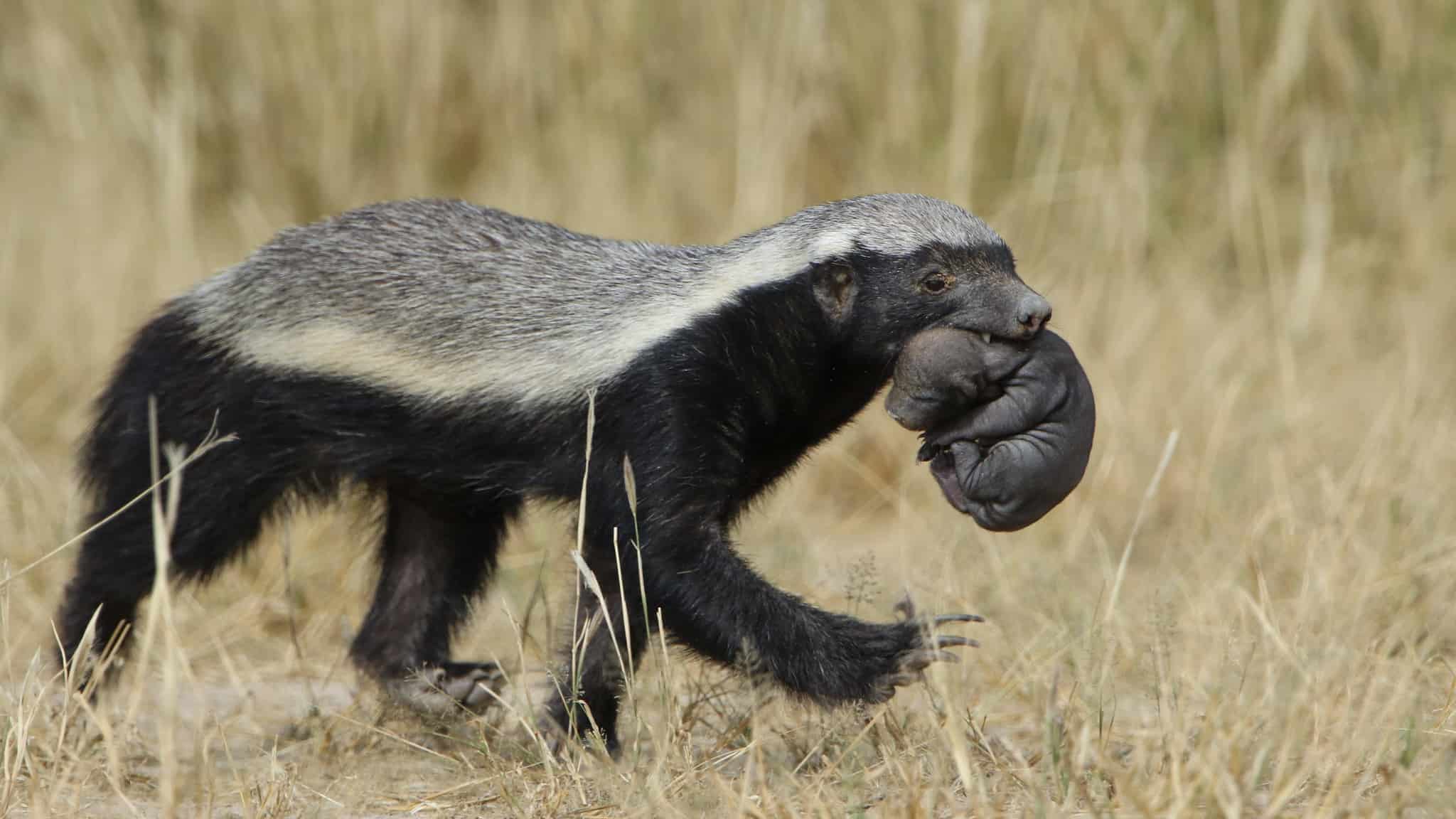
They may not be the king of the jungle, but honey badgers are still respected in the animal kingdom. Despite their smaller size, honey badgers have a huge temper that can intimidate even a group of lions. These fearless honey-eating carnivores may have a bad rep, but there are so many more interesting things to know about them. Find out more with these wild honey badger facts.
- Honey badgers don’t share much similarities with other badger species.
- Honey badgers can weigh around 13.6-30 lbs (6.2-13.6 kg).
- Honey badgers have around 12 subspecies.
- Captive honey badgers can live for up to 24 years.
- They first evolved in prehistoric Asia.
- The honey badger’s scientific name is Mellivora capensis.
- Honey badgers are the sole members of the genus Mellivora and subfamily Mellivorinae.
- They are mostly found in Africa and southern Asia.
- They belong to the mustelids family with weasels, otters, badgers, and ferrets.
- Honey badgers are omnivorous but mostly carnivorous.
- Female honey badgers have four mammary glands.
- They only give birth to one or two babies at a time.
- Baby honey badgers can be called pups, kits, or cubs.
- Male honey badgers are bigger than females.
- They do not have many predators.
- They are the biggest land-living mustelids in Africa.
- Their jaws are strong enough to crush tortoise shells.
- They’re also called ratels.
- Mating honey badger pairs can sometimes hunt together.
- A group of honey badgers is called a cete or clan.
Honey badgers are more similar to weasels than badgers.
Despite what their name suggests, honey badgers have a closer resemblance to overgrown weasels than other badger species. Although true badgers and honey badgers all belong to the weasel family, honey badgers are alone in a distinct genus.
Anatomically, honey badgers differ a lot from true badgers. However, honey badgers also evolved with superficial similarities such as burrowing habits and short, stocky bodies.
They get their names from their honey-eating habits.
As the name suggests, honey badgers regularly raid beehives in search of food. They often look for honeycombs to eat honey and bee larvae. Their scientific name highlights this love of honey, as it translates roughly to “honey-eater of the cape”.
The honey badger diet covers a wide range of food.
While they are primarily carnivorous, honey badgers can eat a wide variety of food. Next to the wolverine, they have the biggest diversity in their diets in the weasel family.
A honey badger’s diet can include berries, vegetables, rodents, small reptiles, and insects. They have also been observed eating young monkeys and even deadly black mambas. How’s that for crazy honey badger facts?
Their thick skin protects them from harm.
Honey badger skin is thick and loose, providing them both protection and flexibility. Their skin allows them to shrug off most bites from predators, as well as stings from bees and porcupines.
If a predator gets a hold of their skin, they can still twist and fight back because the looseness allows them some freedom of movement. Predators who grab them with their jaws are especially in danger of retaliation because the honey badgers can easily reach their faces.
Honey badgers can survive snake venom.
Venom is a snake’s lethal weapon, capable of bringing down horses and other large animals. However, honey badgers couldn’t care less. While their thick skins provide protection against snakebites, honey badgers are also largely resistant to the venom of snakes.
Because snakes such as cobras make up a significant part of the honey badger diet, so honey badgers adapted to tolerate their lethal venom.

Even large predators fear them.
Among the most interesting honey badger facts is that their reputation for being ferocious and defensive. They are even infamous in the animal kingdom, with most animals tending to actively steer clear of them.
Scientists also observed that even large predators like hyenas and lions avoid them if they can, to the point of scaring off whole prides of lions.
They aren’t completely invincible.
Due to their thick skins, most attacks from predators aren’t successful. However, leopards, pythons, and crocodiles occasionally feast on honey badgers. While most honey badgers can tolerate attacks from bees, some have also been found dead near the beehives they were invading.
Honey badgers are great diggers.
These fierce animals have strong claws that could easily dig tunnels into hard ground in a matter of minutes. They have a great sense of smell and mostly get their food from digging out the burrows of other animals, such as mice, springhares, and gerbils. In a single feeding period, a honey badger can dig up to 50 holes.
They can find shelter just about anywhere.
Honey badgers also tend to live under burrows. They don’t have permanent homes and rarely stay in one place. Honey badgers may even sleep in the dens of other animals, not just fellow honey badgers. They have been observed sleeping in the dens of foxes, springhares, and even termite mounds.
Honey badgers do not back down.
One of the most interesting honey badger facts is that the Guinness Book of World Records listed honey badgers as the “most fearless animal in the world”. This claim is backed up by actual honey badger behavior. Honey badgers aren’t afraid of facing animals much larger than them, and will fiercely fight to the death if not left alone.
They will also fiercely attack any intruders that come across their dens. Honey badgers have been observed to challenge large mammals into fights, such as Cape buffalos and rhinoceroses.
Their hunting time is flexible.
Honey badgers are cathemeral, meaning they can be active on both day and night. They are mostly active during the day (diurnal) in the cooler months and active at night (nocturnal) in the warmer seasons. Most badgers living near human settlements, however, are mainly nocturnal.
Like skunks, they can spray foul-smelling liquids.
Honey badgers have anal pouches that can turn inside out and spray a liquid with a strong, pungent odor like skunks. The reason for this behavior is still under scientific debate.
While most agree that the scent is useful for marking their territories and warding off rivals, some suggest that it also helps repel predators. Some scientists even believe that the odor helps calm bees down.
Honey badgers care for their young.
Baby honey badgers are born blind, hairless, and helpless. Mothers raise their cubs alone and carry them to new burrows every few days. The eyes of cubs only open after two months, but they still stay with their mothers for protection and the opportunity to learn important survival skills. The young honey badgers only leave after they reach 14 months of age, sometimes even up to two years.

They prefer to be left alone.
Honey badgers are solitary animals and often hunt alone. These reclusive animals only meet up to mate, then go on their separate ways after mating. Honey badgers can mate at any time of the year, but they prefer the months of September to October.
Female honey badgers tend to stay out of each other’s ways, and there have been no documented cases of female honey badgers grouping together. In cases where their territories overlap, they avoid one another by leaving scent trails to let others know their location.
Despite being solitary, honey badgers have a social hierarchy.
Male honey badgers occupy larger territories than females, and overlapping does occur. Researchers suggest that they have some form of social hierarchy, and males can sometimes travel in groups to search for mates. Dominant honey badgers can sometimes chase away the non-dominant males from mating burrows. Genetic analysis also reveals that dominant males father around half of the cubs in a given area.
One subspecies of honey badger has an all-black coat.
Honey badgers are known for sporting a coat of black and white. While most honey badger subspecies have a large white or grayish band of fur, the black ratel (Mellivora capensis cottoni) lacks this characteristic. Instead, it has a coat of entirely black fur.
Honey badgers can rattle.
Honey badgers are also called ratels, which is an Afrikaans word stemming from the Dutch term for honeycomb. In Afrikaans, the word also means “rattle”. This is mainly due to the rattling sound that honey badgers make when agitated or when fighting.
They are intelligent and resourceful animals.
Only a handful of animals have been observed to use tools in the wild, and the fearsome honey badger is one of them. They are notoriously hard to keep in captivity because they’re known to roll up logs and use them as bridges and ladders, allowing them to escape. They can also use sticks, muds, and stones as tools and have been observed to open gates and beehives.
Sometimes, other animals outsmart them.
Although honey badgers are intelligent and strong at the same time, some animals occasionally take advantage of them. When they forage, honey badgers tend to dig up small animals — but they don’t always catch and eat what they unearth. Researchers have documented jackals and goshawks following honey badgers in an attempt to snatch what they dig up.
They also steal from other predators.
While honey badgers don’t mind hunting for their own food, they have been seen stealing from larger predators, such as lions and hyenas. They may also scavenge the discarded prey of other predators.
Honey badgers don’t make great pets.
Aside from being masters of escape, having a suffocating scent gland, and being generally aggressive, honey badgers are wild animals who can act unpredictably. There have been documented cases of people keeping a pet honey badger, with most of them agreeing that they can be a handful.
Honey badgers can be quite a nuisance.
One of the more well-documented honey badger facts is that they’re destructive. To beekeepers and farmers, honey badgers spell trouble. Because of their sheer strength and intelligence, honey badgers can pry open wooden chicken coops and the hives of honeybees. They’ve also reportedly attacked goats and sheep.
They’re known to engage in surplus killing, or killing more than what they can eat. This often means they can destroy entire flocks of poultry in a coop. There has been a report of one incident where a honey badger killed 36 chickens along with 17 Muscovy ducks.
Honey badgers are also known to attack humans and transmit various diseases, such as rabies. All of these factors make them an unwanted presence in human territories.
They also dig up dead human bodies.
Because of the honey badgers’ digging and scavenging behaviors, it’s not impossible for them to come across already-dead bodies buried underground. Such an event has been reported in the 1941 volume of The Fauna of British India. Honey badgers reportedly can dig up human corpses and eat their remains. The strong jaws of honey badgers make them able to eat even hard bones. How’s that for disturbing honey badger facts?
Honey badgers are hard to kill with traditional weapons.
Humans aren’t too happy when honey badgers invade their homes. As a result, many try to kill them to completely avoid the destruction they may cause. However, they’re notoriously hard to kill. Their skin offers them great protection against most attacks, including dogs, arrows, spears, and even machetes. Honey badgers aren’t bulletproof, however, and can successfully be killed with a bludgeon to the skull or a gunshot to the head.
The British Army had to deny claims of releasing “man-eating badgers” in Iraq.
Rumors arose in 2007 stating that the British Army released “man-eating badgers” in Iraq. They were forced to categorically deny this claim. The reported badgers were found to be honey badgers, and the rumors started when some were spotted near a British base.
Their ears are small and hidden.
The ears of honey badgers are rudimentary and not readily seen. Instead, their small ears only look like tiny ridges on the side of their heads. This may be an adaptive trait and can play a role in mitigating damages during fights.
Honeyguides don’t actually guide honey badgers.
Honeyguides are birds that reportedly work with honey badgers in looking for the hives of honeybees. While it has been suggested that honeyguides eat the scraps from a honey badger’s meal, there is no evidence to support this. However, these birds have exhibited this behavior with humans.
Baby cheetahs mimic their distinctive fur.
Honey badgers are mean and dangerous, and the highly-contrasting color of their fur makes them stand out in the wild. Baby cheetahs also sport a light-colored band of fur on their top portion and dark fur at the bottom, resembling the fur of honey badgers. Although it hasn’t been proven, scientists hypothesize that this may be a form of mimicry. It’s said that this similarity in coloration helps deter would-be predators.

Their population is declining.
Although honey badgers aren’t endangered due to their widespread habitats and few natural predators, they’re currently experiencing a decrease in population. This is largely due to rapidly-expanding human territories, direct hunting from humans, or accidentally consuming poisons originally made for jackals.
People in some areas protect and conserve honey badgers.
Their declining numbers and shrinking territories mean that honey badgers are also near threatened in some areas. As a result, honey badgers are protected in some regions such as the Cape provinces of South Africa.
Was this page helpful?
Our commitment to delivering trustworthy and engaging content is at the heart of what we do. Each fact on our site is contributed by real users like you, bringing a wealth of diverse insights and information. To ensure the highest standards of accuracy and reliability, our dedicated editors meticulously review each submission. This process guarantees that the facts we share are not only fascinating but also credible. Trust in our commitment to quality and authenticity as you explore and learn with us.
